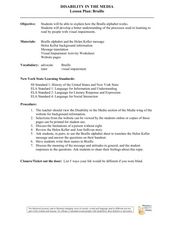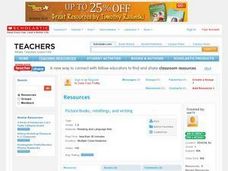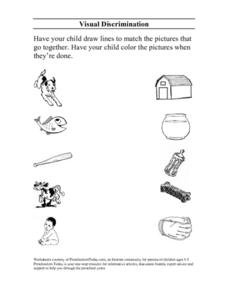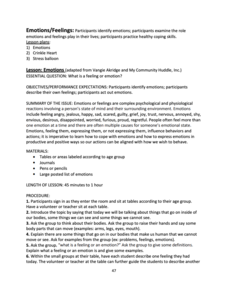Curated OER
Calm Down Visual Cards
Associating a concept with a visual cue or reminder can be a highly effective learning tool for some Autistic or special needs pupils. This template includes images that are associated with specific techniques for calming down. The...
Curated OER
Birthday Visual Schedule
Visual schedules can really help an autistic or special-needs child cope with a social event. Focused on birthdays, this resource helps learners know what to expect and what comes next at a birthday party. Additional suggestions are...
Curated OER
Career Visualization
Students examine the different career choices available. In this career choice lesson students complete several activities including a visualization lab.
Curated OER
Disability in the Media Lesson Plan: Braille
Students determine the workings of the Braille alphabet and how people with visual impairments learn how to use it. In this Braille lesson, students study the associated vocabulary, read about Helen Keller, and complete associated...
Curated OER
Stress Reduction: Visual Imagery
Students use visual imagery in dealing with a stressful situation. They practice the visual imagery in class and at home. They record their reflections in a journal.
Curated OER
Fire Safety Skills
Here is a fire safety lesson specifically designed for blind or visually impaired teens. They will attempt to exit the building safely, feeling for hot spots, heat drafts, and obstacles. A hairdryer, tape recorded fire sounds, and verbal...
Perkins School for the Blind
Safety Skills
Learning how to stay safe in a dangerous situation is of utmost importance, especially when you have a visual impairment or special need. The teacher makes up a set of dangerous scenario cards based on the provided set of guiding...
Curated OER
Picture Books, Retelling, and Writing
Students create stories using only pictures. In this visual storytelling lesson, students read Pancakes for Breakfast by Tomie de Paola and analyze the wordless story. Students create new text for the book by writing on...
Curated OER
Visual Discrimination
In this visual discrimination worksheet, students draw lines to match the pictures that go together. Students color the pictures when finished.
Autism Speaks
Improving Sleep for Children with Autism
Sometimes learners with autism have trouble getting into routines and schedules, especially when it comes to sleep. Quickly refer to a guide that provides tips, checklists, sample schedules, and visuals to help your child become a better...
Champions for Change
How Many Cups Do I Need?
Does an apple a day really keep the doctor away? Find out by browsing through a variety of handouts and learning the recommended daily amounts of fruits and vegetables for good health. Learners will read and discuss how to visually...
Kenan Fellows
Saving Those Who Save Us: Exploring the Use of Sensors with Data Visualization
Sensor technology is amazingly accurate and useful. Combining the sensor technology and mathematical knowledge, scholars design experiments to answer a question they have developed. Questions may focus on light sensing, temperature...
San Diego County District Attorney
Emotions/Feelings
Three lessons delve deep into the topic of feelings and the importance of expressing one's emotions. Through grand conversation, hands-on learning experiences, and reflective writing, scholars interpret the ups and downs of everyday...
Curated OER
Drugs and Safety Precautions
Drugs can both help and harm depending on how they are used. Fifth graders complete a worksheet that provides background information on prescription drugs. They read the text and then describe why medication manufacturers label pill...
Kids' Pages
Feelings Matching 1
Even subtle differences in facial expressions can give us a glimpse into how others are feeling. Through this visual matching activity, youngsters work to correctly connect 16 feelings to their appropriate facial expressions.
Pennsylvania Department of Education
The Digestive System
Fourth graders simulate how the digestive system works. In this hands-on simulation, 4th graders complete six group activities that help students visualize how our body breaks down food into nutrients.
Media Smarts
Sex in Advertising
Converse with your class about the use of sex in advertising. Analyze the biological, emotional, and spiritual connections associated with sex, and how the media uses these affiliations to sell products. Take a closer look at...
Curated OER
Clown Maze
In this clown maze worksheet, 1st graders find their way through the maze of the clown's bow tie. Students then draw a tie on the clown. The objective is to enhance students' fine motor and visual interpretation skills.
Curated OER
Why Can’t I Have Sugar? All About Diabetes
Begin the lesson by having your class write what they know about diabetes. They learn through a skit how the body metabolizes glucose. A visual representation of the two types of diabetes is displayed, and then learners participate in...
Curated OER
Agriculture Awareness Through Poetry
Whether you are viewing a landscape painting of a farm, examining a still-life portrait of a bowl of fruit, or reading a descriptive poem about cultivating food, you can't deny that agriculture plays a major role in visual and language...
Curated OER
Observation Milk Fat Lesson
Turn your class loose to experiment with the different fat content in skim milk, whole milk, half and half, and heavy cream. This is a visually vibrant experiment, as learners drip food coloring on the surface of the products and measure...
Curated OER
Hand Washing
Mostly discussion, this lesson explores the importance and methods of hand washing. A few true stories of community illnesses spread by the neglect of washing hands serve as an anticipatory set. The activity is most memorable if you are...
Twin Cities Medical Society
Should I Talk to My Kids about Vaping?
Enlist parents and guardians in an anti-vaping campaign with an infographic that offers suggestions for how to talk with their students about e-cigarettes and e-liquids. The visual includes information about the dangers of vaping as well...
Media Smarts
Tobacco Labels
Adolescents compare and assess the efficacy of tobacco product health warning labels from around the world. In groups, they invent warnings and create labels that would be effective for teens and children. Discussion covers advertising...
Other popular searches
- Visual Arts
- Visually Impaired
- Visual Art Self Portrait
- Visual Art Lesson Plans
- Teacher Resources Visual Art
- Visual Art Lessons
- Visual and Performing Arts
- Visual Art Lessons Symmetry
- Visual Discrimination
- Visual=art
- Visual Art Tessellations
- Visually Impaired Blind























